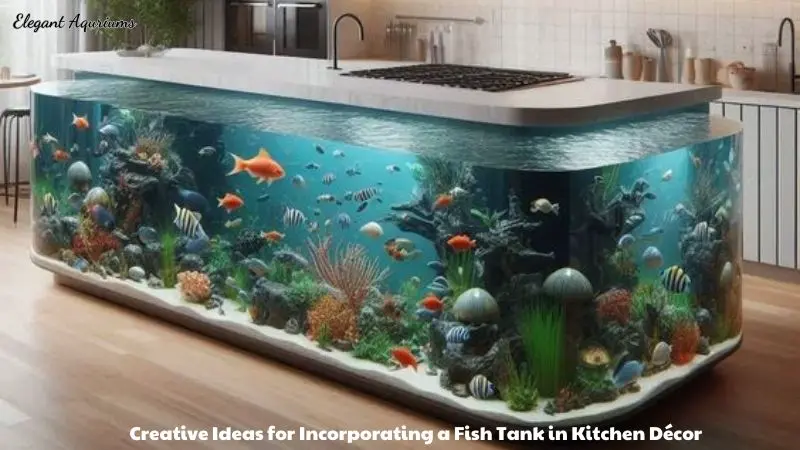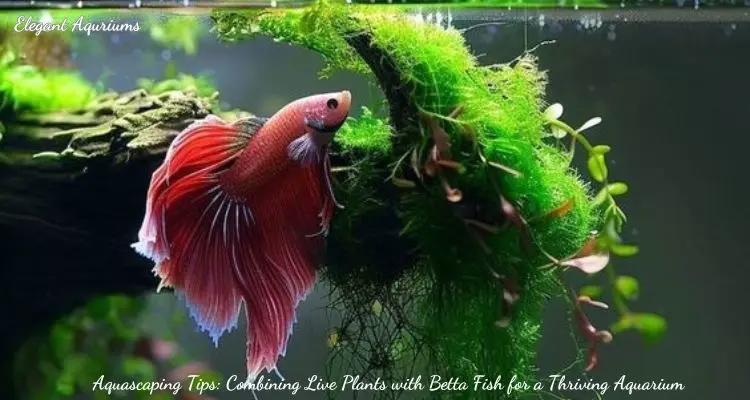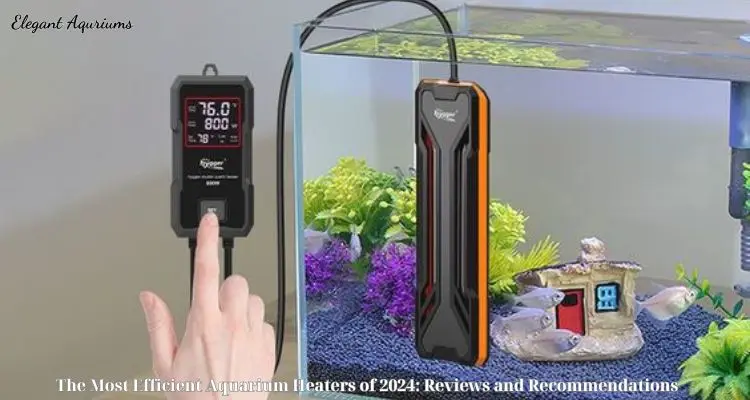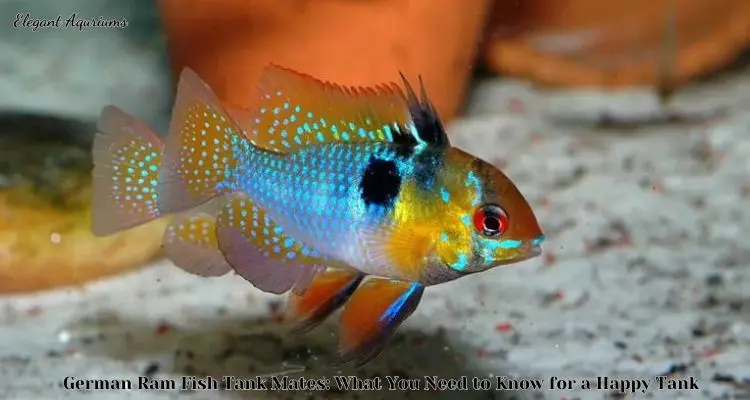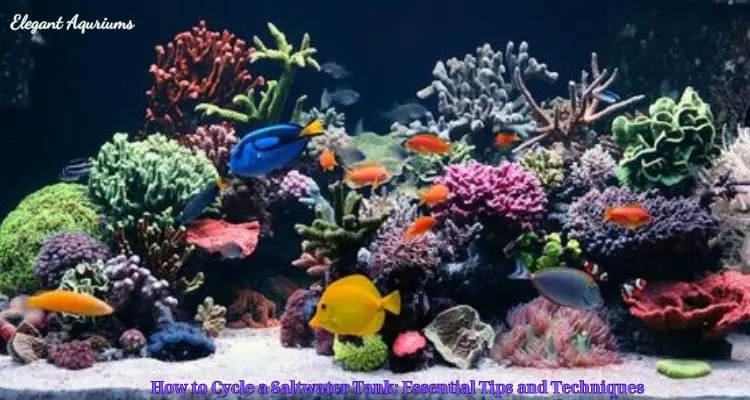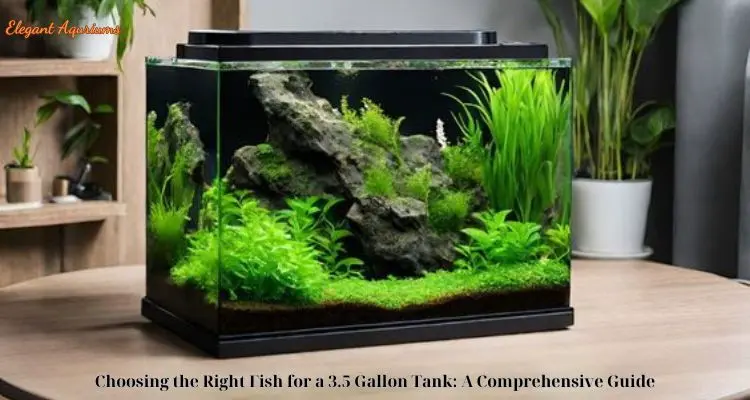Fish tank and equipment
Creative Ideas for Incorporating a Fish Tank in Kitchen Décor
Integrating a fish tank in kitchen can uniquely enhance your space by blending nature with serenity. The movement of fish and soothing water sounds create a calming atmosphere, transforming the kitchen into both a functional area and a relaxing retreat. This article Elegant Aquriums will explores creative ideas for incorporating a fish tank in the kitchen, with a focus on design, placement, maintenance, and overall aesthetic appeal.
Pros and Cons of Placing a Fish Tank in Kitchen Areas
Incorporating a fish tank into your kitchen décor can be a captivating choice that adds both beauty and functionality to the space. However, before installing an aquarium in your kitchen, it’s essential to weigh the advantages and disadvantages to ensure it complements your lifestyle and kitchen layout. Here’s a detailed look at the pros and cons of placing a fish tank in kitchen areas:
Pros
- Aesthetic Appeal: Adds a stunning focal point and enhances kitchen décor with vibrant colors and movement.
- Stress Relief: Provides a calming visual experience, reducing stress and creating a relaxing atmosphere.
- Enhanced Ambiance: Offers soothing water sounds and warm lighting, enhancing the kitchen’s ambiance.
- Educational Opportunity: Teaches about aquatic life and responsibility through regular tank maintenance.
- Space Optimization: Utilizes unused kitchen areas creatively, with some designs integrating into countertops or shelves.
Cons
- Maintenance Challenges: Requires frequent cleaning and water changes due to kitchen grease and particles.
- Space Constraints: May be difficult to place in small kitchens without sacrificing countertop or storage space.
- Potential Hazards: Risks include exposure to heat and contamination from food or cleaning agents.
- Cost Considerations: Involves significant initial setup and ongoing maintenance costs.
- Noise Concerns: Filtration system noise can be disruptive.
- Algae Growth: Kitchen lighting can promote algae, requiring additional maintenance.
Aesthetic Ideas for Integrating a Fish Tank in Kitchen Design
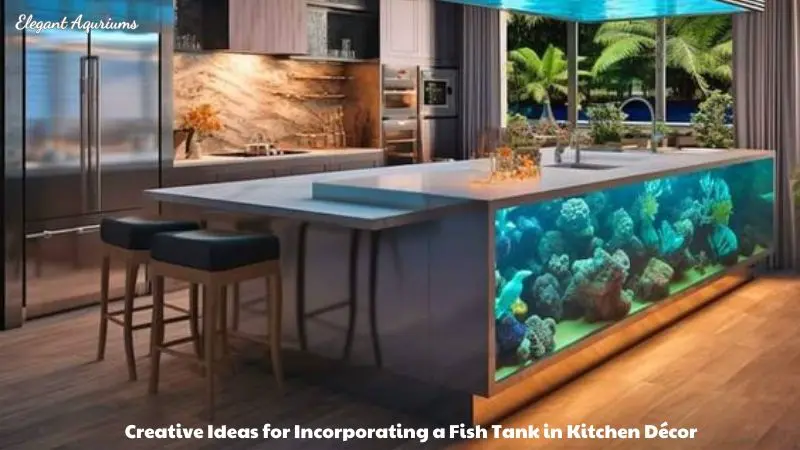
Built-In Fish Tank in Kitchen Cabinets
One of the most seamless ways to incorporate a fish tank in kitchen design is by building it directly into your cabinets. This approach allows the tank to blend in with the kitchen’s overall layout, creating a cohesive and integrated look.
- Customization: You can customize the size and shape of the tank to fit perfectly into your cabinet space. Whether it’s a long, narrow tank running along the length of a countertop or a smaller, more traditional tank nestled within the cabinetry, the possibilities are endless.
- Lighting: Built-in tanks often come with integrated lighting, which can be used to highlight both the fish and the surrounding kitchen area. LED lights are particularly popular, as they can be adjusted to different colors and intensities, adding to the ambiance of the kitchen.
- Functionality: A built-in fish tank can also serve as a functional element in the kitchen. For example, it can be placed at eye level above a sink or stove, providing entertainment and relaxation as you cook or clean. The tank can also be equipped with automatic feeding systems and filtration units that are hidden within the cabinetry, ensuring that maintenance is easy and unobtrusive.
Countertop Fish Tanks
If you’re looking for a less permanent option, a countertop fish tank might be the ideal solution. These tanks are versatile and can be easily moved or replaced, making them perfect for renters or those who like to frequently update their décor.
- Variety of Sizes: Countertop tanks come in a variety of sizes, from small betta tanks to larger aquariums that can hold several fish species. Depending on the size of your kitchen counter, you can choose a tank that complements the space without overwhelming it.
- Design Accents: The fish tank can act as a focal point on the kitchen counter, drawing attention and sparking conversation. You can enhance its appeal by surrounding it with plants, decorative stones, or small sculptures that match your kitchen’s theme.
- Space Considerations: When placing a fish tank on the countertop, consider the amount of space it will occupy. Ensure that it doesn’t interfere with your cooking or prep areas. A smaller tank is often ideal for this purpose, allowing you to enjoy the benefits of having fish in the kitchen without sacrificing functionality.
Fish Tank Kitchen Island
For those looking to make a bold statement, a fish tank kitchen island is a show-stopping option. This design element transforms the kitchen island into a centerpiece that not only serves as a functional work surface but also as a stunning aquarium.
- Unique Design: A fish tank island can be designed with a glass top, allowing you to view the fish from above while preparing meals or entertaining guests. The sides of the island can be constructed entirely of glass, offering a 360-degree view of the aquarium.
- Material Selection: It’s important to choose materials that complement both the tank and the kitchen. Stainless steel, glass, and stone are popular choices for creating a modern, sleek look. You can also opt for wood finishes if you prefer a more rustic or traditional aesthetic.
- Practicality: While a fish tank island is undoubtedly impressive, it’s essential to consider practicality. Ensure that the tank is easy to access for feeding and cleaning. Additionally, the island should be sturdy and stable, able to support the weight of the water and the tank itself.
Wall-Mounted Fish Tanks
Wall-mounted fish tanks are another innovative way to incorporate an aquarium into your kitchen décor. These tanks are space-saving and can be mounted at eye level, making them both functional and decorative.
- Space Efficiency: Wall-mounted tanks are perfect for kitchens with limited counter or floor space. They free up valuable real estate while still providing the benefits of having a fish tank in the kitchen.
- Aesthetic Appeal: These tanks can be framed like artwork, becoming a living painting that adds color and movement to your kitchen walls. The frames can be customized to match your kitchen’s style, whether it’s modern, minimalist, or traditional.
- Maintenance: Wall-mounted tanks often come with built-in filtration and lighting systems, making them easy to maintain. However, it’s important to ensure that the tank is securely mounted to the wall and that it’s accessible for feeding and cleaning.
Under-Counter Fish Tanks
An under-counter fish tank is a subtle yet striking way to incorporate an aquarium into your kitchen. This design involves placing the tank beneath a countertop, where it can be viewed through a glass panel.
- Visibility: The under-counter tank is visible from a standing position, making it an ideal choice for entertaining. Guests can admire the fish while standing around the counter or sitting at bar stools.
- Ambiance: The soft glow from the tank’s lighting creates a warm and inviting atmosphere in the kitchen. The under-counter placement also ensures that the tank doesn’t take up valuable counter space, allowing you to maximize the functionality of your kitchen.
- Installation: When installing an under-counter fish tank, it’s crucial to work with a professional to ensure that the tank is properly supported and that the glass panel is durable enough to withstand daily use.
Partition Fish Tanks
A partition fish tank is an excellent way to divide spaces within an open-plan kitchen while adding a decorative element. This type of tank can be used to separate the kitchen from the dining or living area, creating a natural flow between the spaces.
- Dual-Purpose: The partition tank serves a dual purpose, acting as both a room divider and a stunning visual feature. It allows light to pass through, maintaining an open and airy feel in the kitchen while providing a sense of separation.
- Customization: You can customize the partition tank to match your kitchen’s style. For example, the tank can be framed with wood or metal, or it can be left frameless for a sleek, modern look.
- Maintenance Considerations: Because the tank is visible from both sides, it’s essential to keep it well-maintained. Regular cleaning and water changes are necessary to ensure that the tank remains a beautiful and functional addition to your kitchen.
Fish Tank Backsplash
A fish tank backsplash is a creative and unexpected way to incorporate an aquarium into your kitchen. This design involves installing a long, narrow tank along the backsplash area, creating a continuous line of aquatic life behind your countertops.
- Unique Aesthetic: The fish tank backsplash is a unique design feature that adds depth and dimension to your kitchen. The movement of the fish creates a dynamic visual effect, making the backsplash a focal point.
- Customization: You can customize the tank’s design to match your kitchen’s color scheme and style. For example, you can choose different types of fish, plants, and decorative elements to create a cohesive look.
- Practicality: While a fish tank backsplash is visually stunning, it’s important to consider practicality. The tank must be easy to access for feeding and maintenance. Additionally, the backsplash should be made from materials that are resistant to moisture and easy to clean.
Maintenance Tips for a Fish Tank in Kitchen Environments
Maintaining a fish tank in a kitchen requires extra attention due to the unique challenges posed by the kitchen environment. Here are some practical tips to keep your aquarium in top shape:
Regular Cleaning
- Tank Cleaning: Clean the tank’s interior, including glass surfaces and decorations, regularly to prevent algae buildup and maintain clarity. Use an aquarium-safe cleaner and avoid harsh chemicals.
- Filter Maintenance: Clean the filter and replace media as needed to ensure optimal water quality. Follow the manufacturer’s guidelines for cleaning intervals.
Monitor Water Quality
- Water Testing: Regularly test the water for parameters such as pH, ammonia, nitrites, and nitrates. Use an aquarium water testing kit to keep these levels within the recommended range.
- Water Changes: Perform partial water changes (about 10-20% of the tank volume) weekly or bi-weekly to remove waste and refresh the water. Use a siphon to remove debris from the substrate.
Prevent Contamination
- Food Handling: Keep food preparation and storage areas separate from the fish tank to avoid contamination. Use a designated area for feeding fish and avoid using kitchen utensils near the tank.
- Chemical Avoidance: Avoid using strong cleaning agents or chemicals near the tank. Use non-toxic cleaning products and ensure they don’t come into contact with the aquarium.
Manage Temperature
- Temperature Regulation: Ensure the tank’s water temperature remains stable, ideally between 74-78°F (23-26°C) for most freshwater fish. Use an aquarium heater and a thermometer to monitor and maintain the correct temperature.
- Avoid Heat Sources: Place the fish tank away from direct heat sources like stoves or ovens to prevent temperature fluctuations.
Control Light and Algae Growth
- Lighting: Use aquarium lighting that mimics natural light cycles. Avoid leaving the tank light on for extended periods to prevent excessive algae growth.
- Algae Control: Regularly clean algae from the tank walls and decorations. Consider adding algae-eating fish or invertebrates to help manage algae levels naturally.
Address Noise Issues
- Filter Noise: If the filter is noisy, ensure it is functioning correctly and consider upgrading to a quieter model if needed. Placement and vibration can also affect noise levels, so check for proper installation.
Ensure Proper Placement
- Stable Surface: Ensure the fish tank is placed on a stable, level surface to prevent tipping or accidental spills. A sturdy stand designed for aquarium use is ideal.
- Accessibility: Position the tank where it is easy to access for routine maintenance but not in the way of kitchen activities.
Keep an Eye on Fish Health
- Regular Checks: Observe your fish daily for signs of illness, stress, or unusual behavior. Promptly address any issues to maintain a healthy tank environment.
- Quarantine New Fish: If introducing new fish, quarantine them in a separate tank for a few weeks to prevent potential disease transmission to the main tank.
By following these maintenance tips, you can ensure that your fish tank remains a beautiful and healthy feature in your kitchen, enhancing both your décor and your well-being.
Conclusion
Incorporating a fish tank into your kitchen décor adds life, color, and tranquility. From built-in and countertop tanks to kitchen island installations and portable options, there are many ways to integrate aquatic life into your kitchen. Consider factors like placement, size, maintenance, and overall theme to ensure the tank enhances both aesthetics and functionality. With thoughtful planning, a fish tank can become a stunning centerpiece, transforming your kitchen into a serene and enjoyable space.

